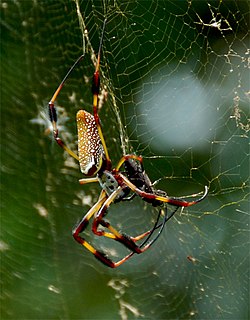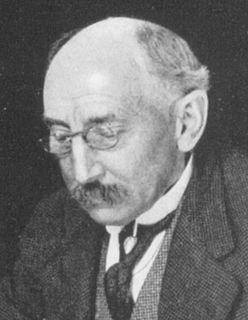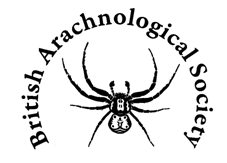Related Research Articles
IAS may refer to:

Arachnology is the scientific study of arachnids, which comprise spiders and related invertebrates such as scorpions, pseudoscorpions, and harvestmen. Those who study spiders and other arachnids are arachnologists. More narrowly, the study of spiders alone is known as araneology.

Norman Ira Platnick was an American biological systematist and arachnologist. At the time of his death, he was a professor emeritus of the Richard Gilder Graduate School and Peter J. Solomon Family Curator Emeritus of the invertebrate zoology department of the American Museum of Natural History. A 1973 Ph.D. recipient at Harvard University, Platnick described over 1,800 species of spiders from around the world, making him the second most prolific spider taxonomist in history, behind only Eugène Simon. Until 2014 he was also the maintainer of the World Spider Catalog, a website formerly hosted by the AMNH which tracks the arachnology literature, and attempts to maintain a comprehensive list, sorted taxonomically, of every species of spider which has been formally described. In 2007 he received the International Society of Arachnology's Bonnet award, named for Pierre Bonnet, in recognition of his work on the catalog.
Proszynskiana is a genus of Asian jumping spiders that was first described by D. V. Logunov in 1996. It is named in honor of arachnologist Jerzy Prószyński.

Pierre Bonnet was a French arachnologist who wrote Bibliographia Araneorum, an immense work listing publications on spiders. It was the result of forty years of work.
Tamara Mkheidze was a Georgian arachnologist.

William Joseph Rainbow (1856–1919) was an entomologist and arachnologist whose work includes the first catalogue of Australian spiders.
Herbert Walter Levi was professor emeritus of zoology and curator of arachnology at the Museum of Comparative Zoology, Harvard University. He was born in Germany, educated there and at Leighton Park School, Reading in England. He then received his higher education at the University of Connecticut and the University of Wisconsin. Levi authored about 150 scientific papers on spiders and on biological conservation. He is the author of the popular Golden Guide Spiders and their Kin, with Lorna Rose Levi and Herbert Spencer Zim.
The International Society of Arachnology (ISA) promotes the study of arachnids and the exchange of information among researchers in this field. It acts as an umbrella organisation for regional societies and individuals interested in spiders, and related animals, and organises an International Congress every three years.

The American Arachnological Society (AAS) is a scientific organization founded in 1972 in order to promote the study of arachnids by seeking to achieve closer cooperation and understanding between amateur and professional arachnologists along with publication of the Journal of Arachnology. The society holds annual meetings around the United States and membership is open to all individuals who share the common objectives held by the society.

The British Arachnological Society (BAS) is the UK’s first body devoted exclusively to the study of arachnids. The primary objectives of the Society are to encourage interest in arachnology in people of all ages and to generate, promote and disseminate arachnological knowledge and understanding by all suitable means. In particular, it works to foster co-operation between amateur and professional arachnologists.
David B. Hirst is an arachnologist previously based at the South Australian Museum in Adelaide. He left the Museum on 22 February 2011. He has described more than 40 species and genera in the huntsman spider family, Sparassidae, and was regularly called on by New Zealand authorities to identify huntsman spiders that entered their country.

Dmitry Evstratievich Kharitonov, also spelt Charitonov, was the first native Russian arachnologist. In 1916 he founded the arachnological school of Perm State University, the oldest arachnology research group in Russia. The culmination of his work was the comprehensive Katalog der russischen Spinnen, published bilingually in 1932, with an addition published in 1936. He grew up under the supervision of Dmitry Mikhailovich Fedotov, an arachnologist from St. Petersburg. One of his postgraduates, T.S. Mkheidze, has been working in Georgia since the 1930s.

Pekka T. Lehtinen is a Finnish arachnologist and taxonomist. He is known for his works in systematics and for the many expeditions in which he has participated.
Valerie Todd Davies was an arachnologist who described many species of spider.
Okumaella is a monotypic genus of East Asian comb-footed spiders containing the single species, Okumaella okumae. It was first described by H. Yoshida in 2009, and is found in Japan. This genus is named in honour of the Japanese arachnologist Chiyoko Okuma.
Michael I. Saaristo was a Finnish arachnologist, with a particular interest in the spiders of the Seychelles. The World Spider Catalog lists 61 genus names or synonyms and 109 species names or synonyms of which he is the sole or co-author.
The Australasian Arachnological Society is a body dedicated to promotion of knowledge and study of arachnids in the Australasian realm, which includes Australia, New Zealand, South-east Asia, Oceania and the Pacific Islands. Membership is open to all individuals and scientific institutions. The Society maintains a large library of reference books and scientific journals housed at Queensland Museum. The society is informally structured to promote the study of arachnology to amateurs, students, professionals and institutions.
Ekaterina Mikhailovna Andreeva also known as Katarzyna Andrejewa-Prószyńska was an Uzbek arachnologist. She collected spiders in Central Asia and later published Spiders of Tajikistan. At least eight spider and harvestman taxa were named in her honor.

Father Chrysanthus O.F.M. Cap., born Wilhelmus Egbertus Antonius Janssen, was a Dutch priest and biology teacher. He was known for his studies in arachnology. Initially he was concerned with the spiders of the Netherlands but he became a specialist on New Guinea spiders. Two spider species were named in his honor following his death.
References
- ↑ "Iranian Arachnological Society (IAS) Homepage". Archived from the original on 2016-10-06. Retrieved 2011-04-19.
- ↑ "Iranian Arachnological Society (IAS) News" . Retrieved 2011-04-19.